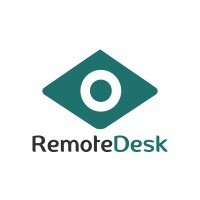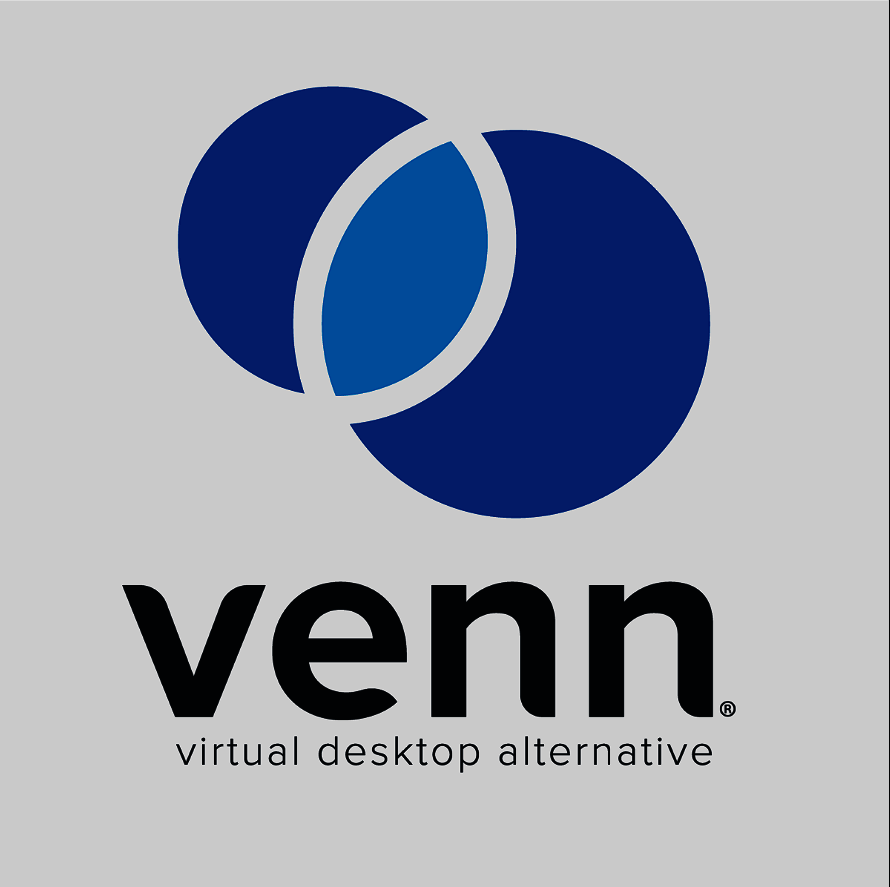Yes, remote working software is accessible across numerous devices and platforms, allowing employees to work on their preferred device and operating system. This increases flexibility and efficiency while also supporting teams with a variety of device choices. Furthermore, cloud-based solutions enable remote working software to be accessible from any location with an internet connection, increasing its accessibility and convenience.
List of 20 Best Remote Working Software
RemoteDesk is a software that streamlines remote employee management for companies of all sizes. Its intuitive interface and advanced AI monitoring allow for a seamless experience. Schedule a demo today to unlock the full potential of this feature-pa...Read More Remotedesk
DesktopReady, Windows 10 cloud desktop solution that prioritizes security, compliance, and efficient performance. Built on the reliable Azure platform, it eliminates upfront costs and offers 24/7 service desk support for a seamless user experience. M...Read More DesktopReady
Snaphunt is a global remote hiring platform that connects fast-growing companies with the best talent worldwide. Our efficient platform simplifies the process of finding, engaging, and hiring top professionals for your team, regardless of their locat...Read More Snaphunt
FreJunHR is a AI interviewing platform revolutionizing the recruitment process. Our software offers advanced features such as automated scheduling, documented calls, personalized interview notes, and AI-driven analytics, streamlining the entire inter...Read More FreJunHR
Jamm the web-conferencing software perfect for remote teams to conduct efficient video conferences. With effortless compatibility across all internet-connected devices, Jamm provides a streamlined solution for seamless communication. Simply launch th...Read More Jamm
Krisp is a remote working solution for boosting the productivity of virtual teams. This innovative software ensures smooth and clear online meetings, allowing for uninterrupted communication with remote colleagues. Say goodbye to disruptive backgroun...Read More Krisp
LogMeIn offers and convenient solution for setting up a reliable remote desktop. Simplify your workflow, securely share data, and increase your productivity with this software. Bid farewell to lengthy configurations and embrace a seamless remote desk...Read More LogMeIn
Clonadesk is a remote access software that eliminates distance barriers and enables effortless collaboration. With its powerful features, businesses can now easily connect with clients and provide top-notch customer service and technical support. Emb...Read More Clonadesk
TeamViewer Remote is an advanced remote desktop and screen-sharing software that allows you to effortlessly access and control remote devices or computers over the internet. It offers versatile features like file transfer, remote control, and online...Read More Teamviewer Remote
IDoneThis is a tool for task management, progress tracking, and team collaboration. Our seamless integrations and timely notifications keep you on track, so you never miss a deadline again. Streamline your productivity with IDoneThis and say goodbye...Read More IDoneThis
Meet Engage App is a office management platform that simplifies workplace reservations and seamlessly connects with essential office tools. Perfect for coworking and corporate spaces, this user-friendly solution enhances productivity and enhances the...Read More Engage App
Google Hangouts is a communication solution that effortlessly connects across all your devices. With the ability to start a chat on your computer and seamlessly continue on your phone or tablet, stay in touch with loved ones and colleagues wherever y...Read More Google Hangouts
SeQure is a tool for efficiently managing internal employee helpdesk tickets. Our mobile platform offers a plethora of features to expedite support ticket resolution and provide timely assistance to your remote workforce. With SeQure, you can easily...Read More SeQure - Internal Helpdesk
Venn - our groundbreaking, patented software tailored for Secure BYO-PC. Work remotely with confidence on any unmanaged or BYOD computer without the expense of virtual desktops or strict limitations. Simplify your remote work experience with Venns af...Read More Venn
Reactiv STAGE is the premier platform for seamless online collaboration. With Reactiv STAGE, hosts and participants can easily share visual data, annotate native files, and enhance overall engagement. Say goodbye to traditional virtual meetings and h...Read More Reactiv STAGE
Nibol is a solution for seamless workplace management. Its innovative Work From Anywhere feature lets you easily book desks and meeting rooms not just in your office, but also in various co-working spaces and versatile venues. Say farewell to the ted...Read More Nibol
Pumble is the leading free alternative to Slack, perfect for small businesses and remote teams. With a user-friendly interface, unlimited users, and instant chat history, Pumble simplifies team communication. Additionally, its self-hosting feature gi...Read More Pumble
Workshots- a state-of-the-art employee time tracking and productivity management tool. Effectively monitor your teams tasks and maximize their work hours effortlessly. Get a clear understanding of their time usage and efficiency with live tracking an...Read More Workshots- An Employee Time Tracking App
Todoist is a dynamic project management software that offers flexibility to tailor to your unique requirements. It effectively organizes your sales pipeline, tracks budget, manages resources, and monitors project progress. Its automated workflow boos...Read More Todoist
Desktop.com solution for individuals and teams to effortlessly create and collaborate on multiple online desktops. Our platform boasts a user-friendly interface, providing easy organization and access to all your apps, tools, and links from any devic...Read More Desktop.com
Learn More About Remote Working Software
- What Is Remote Working Software?
- What Are The Recent Trends In Remote Working Software?
- Benefits Of Using Remote Working Software
- Important Factors To Consider While Purchasing Remote Working Software?
- What Are The Key Features To Look For In Remote Working Software?
- Why Do Businesses Need Remote Working Software?
- How Much Time Is Required To Implement Remote Working Software?
- What Is The Level Of Customization Available In Remote Working Software?
- Which Industries Can Benefit The Most From Remote Working Software?
- Conclusion
What Is Remote Working Software?
Remote working software, often known as virtual collaboration software, is a powerful technology that allows individuals and teams to efficiently collaborate from various locations and time zones. This sort of software has a number of features that improve communication, project management, and task tracking, allowing professionals to remain connected and productive while working remotely.
One of the most important features of remote working software is video conferencing, which enables team members to hold face-to-face meetings regardless of their physical location. This tool allows for screen sharing, document collaboration, and real-time chat, making it ideal for virtual meetings, presentations, and brainstorming sessions.
Project management tools are another significant element of remote working software, since they allow teams to plan, coordinate, and track projects from a single platform. With features such as work assignment, deadline setting, and progress tracking, this program simplifies remote project management and ensures task completion on time. Additionally, many remote working software includes file sharing and storage features, making it easier for teams to access and collaborate on documents in real time.
This reduces the need to frequently email back and forth, saving time and avoiding version control problems. Remote working software is becoming increasingly popular in today's fast-paced workplace, especially as remote and distributed teams become more common. This software enables firms to adapt to an ever-changing business landscape while maintaining good communication and collaboration among workers.
When considering purchasing remote working software, it is critical to examine your team's individual needs and select a product that fits your workflow and expectations. Usability, scalability, and integration with other tools and platforms are all important considerations. Teams may overcome the constraints of distance and time zones by using the correct remote working software, resulting in smooth collaboration and productivity even when working remotely.
What Are The Recent Trends In Remote Working Software?
The world of remote work has grown dramatically in recent years, increasing the demand for efficient and functional remote working software. Companies of all sizes are seeking for solutions to enable their employees work remotely while remaining connected and productive. As a result, numerous trends in remote working software have emerged to meet the unique needs of modern remote teams.
Let's explore, we'll go over some of the latest trends in remote working software to help you make an informed decision when selecting the best tool for your firm.
1. Cloud-Based Solutions: One of the most significant trends in remote working software is the transition to cloud-based solutions. With the rise of remote work, enterprises are looking for software that allows them to easily and securely access their tools and data from any place. Cloud-based solutions provide the benefits of flexibility and scalability, allowing teams to collaborate effortlessly from diverse locations without compromising security.
2. Collaboration And Communication Tools: Another trend in remote working software is an increased emphasis on collaboration and communication tools. Remote teams rely significantly on technology to stay connected, thus there has been an increase in software that allows for real-time communication and collaboration. These technologies include video conferencing, remote desktop sharing, project management, and team chat apps, which make it easier for remote teams to collaborate effectively.
3. Automation And Integration: Automation and integration are becoming increasingly common in remote working software. With the rise of remote work, businesses are searching for software to automate time-consuming operations like data entry, file sharing, and project management. Integration features are particularly important since they enable disparate technologies to collaborate, streamlining workflows and enhancing productivity.
4. Virtual Desktop Infrastructure (VDI): In recent years, there has been an increase in the use of virtual desktop infrastructure technologies. VDI allows employees to access their work desktop and applications from any device, ensuring a consistent working experience regardless of location. This trend is especially beneficial for companies with a big remote workforce since it assures employees have consistent access to the same tools and data.
5. Concentrate On Security: With the rise of remote work, data security has become a primary priority for businesses. As a result, there has been a shift toward remote working software that includes strong security features including data encryption, password protection, and remote data wiping. These measures ensure that important company information is protected, even when workers work remotely.
Benefits Of Using Remote Working Software
Remote working software has been increasingly popular in recent years, and for good cause. This type of software provides numerous advantages for individuals and teams who operate remotely, making it an indispensable tool for both enterprises and freelancers alike.
Let's explore, we'll look at the main advantages of using remote working software and why you should consider investing in it.
1. Improved Communication And Collaboration: One of the most difficult aspects of remote work is remaining connected and working successfully with team members. Remote working software enables smooth connection with capabilities such as video conferencing, instant messaging, and file sharing. This not only keeps team members engaged, but also increases productivity and efficiency.
2. Increased Flexibility And Mobility: Remote working software allows people to work from anywhere, including their homes, coffee shops, and while traveling. This flexibility promotes a better work-life balance while eliminating the necessity for a physical office space. It also encourages a more accessible workplace for people with impairments or who are unable to commute to a regular office.
3. Cost Savings: Remote working software can save firms a lot of money by removing or lowering the requirement for a physical office. This includes expenses like rent, utilities, office supplies, and transportation costs. It can also save people money because they no longer have to pay for transportation or lunch.
4. Increased Productivity: Research has shown that remote workers are often more productive than their office colleagues. This can be linked to variables such as reduced distractions, tailored workspaces, and the ability to work during peak productivity hours. Remote working software also enables improved time management and tracking, ensuring that activities are performed on time.
5. Improved Data And Security: Remote working software frequently includes advanced security features, such as data encryption and multi-factor authentication, to safeguard critical information. It also provides for simple data backup and recovery, reducing the possibility of losing vital files in the event of a technical problem or device malfunction.
6. Improved Work-Life Balance: Remote working software gives employees greater choice over their work schedule, resulting in a better work-life balance. This can result in better job satisfaction, improved mental health, and even the attraction and retention of top talent for organizations.
Important Factors To Consider While Purchasing Remote Working Software?
When it comes to choosing remote working software, there are numerous critical elements to consider. As the need for flexible work arrangements grows, businesses are seeking dependable solutions that can support remote or distributed teams.
Let's explore, we'll go over the major factors that might help you make an informed selection when choosing remote working software.
1. Features And Functionality: The first step in assessing remote working software is identifying your individual requirements. What capabilities and functionalities are required for your team to effectively collaborate remotely? Some popular features to check for are virtual meetings and conference calls, document sharing and collaboration tools, task management, and project tracking. Make sure the software you purchase has the necessary capabilities to meet your specific business needs.
2. User-Friendliness: Remote working software should be simple to use for everyone on your team, regardless of technical ability. Look for a user-friendly layout and straightforward navigation to help your employees save time and learn faster. Consider whether the program can be accessible on a variety of devices, including laptops, tablets, and smartphones, to ensure your team's flexibility and convenience.
3. Security: Data security is a primary concern when working remotely. With important company information accessible and shared from multiple places, it is critical to select software that provides a high level of security. Check if the program employs encryption to protect data, supports multi-factor authentication, and integrates with your company's existing security measures.
4. Scalability: Your company and team may increase in the future, therefore it is critical to select remote working software that can scale with your needs. Consider whether the program provides add-ons or expansions that can expand its capabilities as your firm grows. Furthermore, check that the software can support a big number of users and handle massive files and documents.
5. Integration Capabilities: Your remote working software should interact effortlessly with the various tools and applications that your team employs. This can include project management systems, communication tools, CRM software, and other applications. Integration capabilities not only increase productivity, but they also help to streamline operations and reduce the possibility of errors and delays.
6. Customer Support: Proper technical support and customer service are essential when purchasing any software, especially remote working software. Look for a company that provides 24-hour assistance, several routes of communication, and a responsive help desk. This ensures that any technical difficulties are rectified quickly, reducing delays to your team's work.
What Are The Key Features To Look For In Remote Working Software?
As the need for remote work grows, firms must have the necessary tools in place to provide seamless communication, collaboration, and task management. This is where remote working software comes in, providing a variety of capabilities to help remote teams and streamline their operations.
When looking for the best remote working software, consider the following crucial features:
1. Communication Tools: Effective communication is critical for remote teams and should be a top priority when choosing remote working software. Look for platforms that provide a variety of communication methods, including video conferencing, direct messaging, and team-wide conversations. Check for capabilities that enable improved collaboration, such as file sharing, screen sharing, and whiteboarding.
2. Task Management: Remote working software should also have comprehensive task management features to assist teams keep organized and on top of their duties. Look for features like task assignment, deadlines, progress tracking, and configurable workflows to help streamline procedures and increase productivity.
3. Security: When selecting remote working software, ensure that confidential company information and sensitive data are secure. Ensure that the platform provides secure login, data encryption, and access controls to guard against cyber threats and unauthorized access.
4. Integration Capabilities: No firm runs on a single piece of software, which is why remote working software must have integration features. Look for platforms that can link with your current tools, such as project management systems, CRM software, or email clients, to maintain a consistent flow of information across all platforms.
5. Mobile Compatibility: Remote work frequently requires working from multiple locations and devices, thus having remote working software that is compatible with mobile devices is critical. Look for systems that offer mobile apps or responsive web design, allowing for easy access and functionality on smartphones and tablets.
6. Analysis And Reporting: Data and analytics are useful tools for monitoring productivity and identifying opportunities for improvement. Look for remote working software that includes reporting and analytics capabilities to provide insights into task completion, communication, and overall team success.
Overall, the most important qualities to look for in remote working software are those that improve communication, cooperation, and productivity while also assuring remote process security and efficiency. Keep these factors in mind when you compare different solutions to determine the best match for your remote staff.
Why Do Businesses Need Remote Working Software?
Remote working software has become a crucial tool for firms in a variety of industries, particularly recently. With the advent of remote work and the growing demand for flexibility and efficiency, an increasing number of businesses are turning to remote working software to optimize their processes and assure seamless operations. One of the key reasons why firms use remote working software is to improve productivity and communication among team members.
Teams may collaborate effectively using remote working software, regardless of their physical location. This ensures that projects are completed on schedule and without significant delays. Furthermore, remote working software includes a variety of capabilities that help firms manage their remote labor successfully. These include time tracking, work management, and project scheduling, among others.
These features not only allow organizations to track their employees' progress, but they also provide insights into how to improve their efficiency. In addition to productivity and communication, remote working software provides additional security safeguards to safeguard important company data. With the rise of cyber dangers, organizations cannot afford to compromise data security, particularly when workers work remotely.
Remote working software offers safe platforms for transmitting files and private information, reducing the likelihood of data breaches. Furthermore, remote working software allows organizations to dramatically minimize overhead expenditures. Companies can save a lot of money by removing the requirement for real office space and reducing travel expenses.
This can be especially useful for startups and small enterprises aiming to reduce expenses and maximize resources. Finally, remote working software enables organizations to attract and retain great personnel from anywhere in the world. This enables businesses to access a varied pool of competent personnel, giving them a competitive advantage in the marketplace.
How Much Time Is Required To Implement Remote Working Software?
The time it takes to install remote working software depends on a number of factors, including the size of your team, the complexity of the software, and the level of customization necessary. However, completely implementing and integrating remote working software into your team's workflow might take anywhere from a few days to a few weeks. Several critical tasks must be completed during the implementation process.
First, select the appropriate program for your team's specific requirements. This can include studying several possibilities, trying demos, and consulting with your staff to identify their preferences and needs. Once you've decided on the program, the implementation phase can begin. This usually include creating user accounts, establishing settings and permissions, and connecting the program with any other tools or systems your company utilizes.
Depending on the program, you may also need to train your team on how to use the new system efficiently. It's worth noting that if you have a larger team or need considerable customisation, the implementation process may take longer or be more complex. It's also critical to carefully plan and schedule enough time for the implementation process to avoid any potential disruptions to your team's productivity.
What Is The Level Of Customization Available In Remote Working Software?
Remote working software provides a variety of customization possibilities to meet the various needs of its customers. The level of customisation accessible in these tools varies according to the software supplier and the features available. However, the most popular modification possibilities are personalizing the interface, enabling collaboration capabilities, and integrating with other applications.
To begin, most remote working software allows users to customize the interface to meet their specific needs. This involves adjusting color palettes, layout, and text sizes. Such customisation not only improves the user experience, but it also boosts productivity by creating a pleasant and familiar environment. Second, remote working software frequently includes collaboration features that may be tailored to the specific requirements of a team or organization.
These technologies could include virtual whiteboards, team chat, video conferencing, and project management software. Users can select which tools to enable and adapt to meet their communication and collaboration needs. Furthermore, remote working software can be connected with other apps and platforms to offer a high level of customization.This allows users to optimize their productivity by effortlessly linking the various products they use for work.
For example, someone who uses a project management application can combine it with a time tracking app to correctly assess their productivity. Furthermore, certain remote working applications allow for considerable customization, such as designing custom workflows, automating tasks, and setting up customizable notifications and reminders. These features can be especially valuable for teams and organizations who want to adjust the program to their specific workflows and processes.
Which Industries Can Benefit The Most From Remote Working Software?
Remote working software has grown in popularity in recent years, particularly as remote and distributed teams have become more prevalent. This type of software enables employees to work from anywhere, giving them the freedom and technology they need to complete their responsibilities efficiently. While the advantages of remote working software are obvious in many businesses, some can benefit from its functions and features more than others.
The IT industry is one that can benefit greatly from remote working software. Because technology firms frequently operate globally with personnel scattered across multiple time zones, remote working software can help them streamline communication, collaboration, and project management. Remote working software, which includes capabilities like real-time communications, task assignment, and file sharing, can boost productivity and efficiency in the technology industry.
Additionally, the healthcare business can benefit from remote working software, particularly in view of the ongoing COVID-19 pandemic. With the necessity for social distancing and the rise of telehealth services, remote working software allows healthcare practitioners to connect with patients afar and provide virtual consultations and support.
This not only enables healthcare practitioners to continue providing services during these exceptional times, but it also provides patients with a safe and easy means of accessing healthcare. Another field that might tremendously benefit from remote working software is education. With the growing popularity of online education and distance learning, remote working software can let educators teach and connect with students electronically.
Remote teaching and learning can be facilitated by features such as video conferencing, screen sharing, and virtual whiteboards, allowing students to participate from any place. Other industries that can profit from remote working software include consulting, marketing, and professional services. These industries frequently employ remote workers and require excellent communication, teamwork, and project management to provide services to clients. Remote working software can give a centralized platform for teams to collaborate and manage their progress, resulting in timely and high-quality outputs for clients.
Conclusion
Finally, finding the correct remote working software will help your firm increase production and efficiency. Before making a purchase, you should evaluate your team's individual demands and requirements, such as collaboration tools, communication alternatives, and security features. Take the time to explore and compare several software solutions to determine which one best fits your budget and provides the capabilities you require.
Remember to evaluate the software's scalability as your business develops and expands. Furthermore, make sure that the software you chose works flawlessly with your existing tools and processes. This will save time and effort in the long run while also allowing your team to transfer more smoothly. Finally, choose software that provides trustworthy technical support and regular upgrades to ensure a smooth and hassle-free remote working experience. With these things in mind, you can confidently make an informed selection and select the remote working software that best meets your company's requirements.
Remote Working Software FAQ's
Can Remote Working Software Be Accessed Across Multiple Devices And Platforms?
Is Remote Working Software Future-Proof And Adaptable To Emerging Technologies Like AI, Blockchain Or IoT?
Remote working software is unquestionably future-proof and adaptable to upcoming technologies like as artificial intelligence, blockchain, and the Internet of Things. With technological improvements and an increased demand for remote work, these software solutions are continually improving to meet the changing needs of the workforce.
AI, blockchain, and IoT integration can improve remote working software's usefulness, security, and efficiency, making it a viable tool for enterprises of all sizes in the future.
Is There A Free Trial Offered To Assess Remote Working Software Before Committing?
Yes, many remote working software providers provide a free trial period, often spanning from 14 to 30 days, allowing users to fully evaluate the features and capabilities before making a commitment. This trial period enables firms to discover whether the software is a good fit for their remote working requirements without incurring any financial obligations. However, it is crucial to note that certain functionality may be restricted during the trial period.
Does Remote Working Software Offer Data Security Features And Meet Regulatory Compliance Standards?
Yes, most remote working software includes data security features like end-to-end encryption and multi-factor authentication to safeguard the confidentiality of critical information. These programs also follow industry requirements, such as GDPR and HIPAA, to ensure strong data protection standards.
With the advent of remote work, firms are placing a greater emphasis on data security and compliance, making remote working software an invaluable tool for creating a secure and compliant remote work environment.
Can Remote Working Software Integrate Seamlessly With Existing Tools And Platforms?
Yes, most remote working software is designed to function seamlessly alongside existing tools and platforms. This means that employees can continue to use their preferred tools and processes while simultaneously leveraging the remote working software's capabilities and benefits.
The integration process is typically straightforward and needs little effort, allowing for a speedy and effective shift to remote working. This improves productivity and streamlines workflow for distant teams.






















